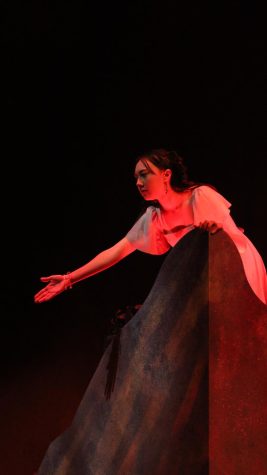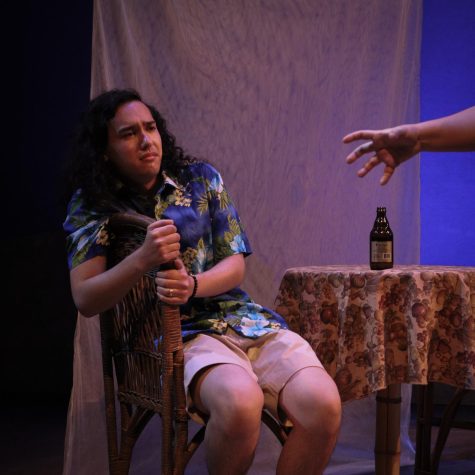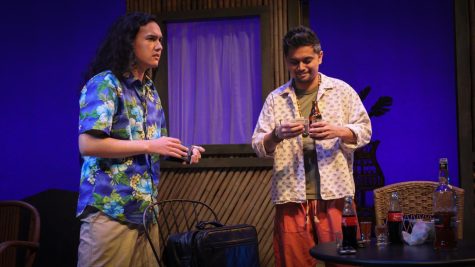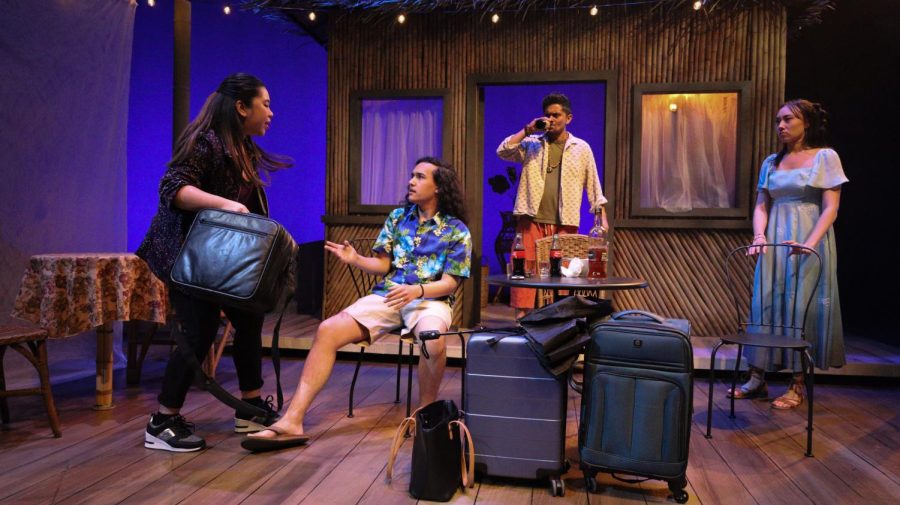On Feb. 17, audience members filled the auditorium of the Dramatic Arts Mainstage to be the first to see San Diego State University’s School of Theatre, Television and Film’s production of “Bloodletting.”
“Bloodletting” follows the journey of two siblings, Farrah and Bosley, who travel from the United States to the Philippines to fulfill their father’s last wish: to have his ashes scattered in his ancestral homeland.

Stranded by a storm at the “Princess Café,” the siblings are taken in by owners Leelee and Jenry. The one-act play centers upon their evening at this tiny restaurant, where family secrets are revealed, supernatural discoveries are made and painful memories resurface.
The intimate layout of the Mainstage brought the audience right up close to the set, involving them in the action. The fog effects seeping around the small wooden shack and the constant sound of chirping crickets transported viewers into the humid setting of Palawan, Philippines.
The use of lighting was even more effective in creating atmosphere as the blood-red moon projection above the set created a sense of foreboding and danger throughout.
The small four-person cast managed to completely bring the script to life.
Sierra Goria fully encapsulated the dynamic character of Leelee, the unhinged but endearing “aswang” witch. Wilfred Grant Paloma also stole the show with his comedic portrayal of Grandfather Jenry. Paloma’s sly asides caused eruptions of audience laughter throughout and provided necessary moments of light in what was a fairly disturbing and dark play.
With their iPads, suitcases and garish Hawaiian shirts, Bosley, played by Nathan Moore, and Farrah, played by Dey Ilagan, excelled in embodying the roles of the stereotypical Filipino American tourists with little knowledge of the locals’ culture.
This idea of cultural difference was not only reflected in the fantasy world of the play, though. According to Ilagan, who is a first-year M.A. theatre arts student from the Philippines, cultural conversation dominated the rehearsal space.
Whilst Ilagan herself grew up in the Philippines, other cast members are half-Filipino or have differing East Asian roots.
“We have a cultural exchange between us,” Ilagan said. “I don’t know as much about America as Sierra does, and she doesn’t know as much about the Philippines as me.”

This cultural exchange also extended to the production department.
“What’s nice is that when we have staff who are part Filipino, it gives them a chance to get to know their roots through this production,” Ilagan said.
On its surface, the play is a dramatic telling of Filipino folklore, in which legends of vampiric “aswang” witches feed off of unborn babies and sow terror among little children.
However, a much deeper message became apparent: the importance of being kind to the ones you love and the danger of taking them for granted.
Professor Randy Reinholz, the director of “Bloodletting,” has been championing native theater artists throughout his career, and hopes that the audience will see their own experiences reflected within the play.
“I think the message you get out of the play has a lot to do with who you are, and what you come to the theater thinking about that night,” Reinholz said.
For audience member Monica Rivera, a fourth-year English major, the play was particularly impactful.
“(The play) was really emotional and very touching,” Rivera said. “My favorite part was definitely when (Farrah) spoke about her father and was trying to be understanding about her brother.”

The play emphasizes the notion of “good and evil” being far too binary.
“There’s a little bit of an ‘aswang’ in all of us. It’s our bad side. It’s when we treat the ones we love negatively,” Ilagan said. “Just because a legend comes from a certain part of the world, (it) doesn’t mean the lessons from it can’t be universal.”
With the play running until Feb. 24, the cast and production team looks forward to the playwright of “Bloodletting,” Boni B. Alvarez, coming to see the play on closing night.
If the performance is as successful as Feb. 17, there is no doubt that Alvarez will be impressed with this very special interpretation.
For those interested in viewing “Bloodletting,” tickets can be purchased here https://ttf.sdsu.edu/events/bloodletting.










